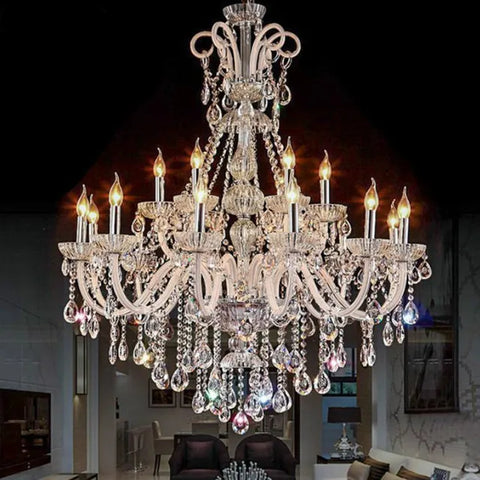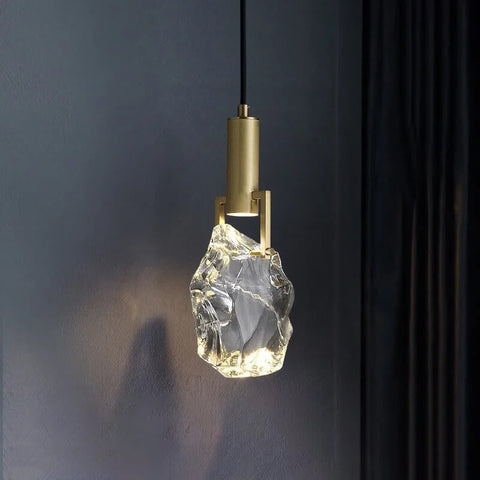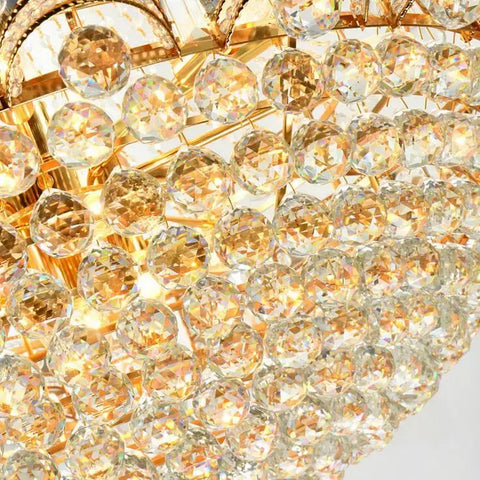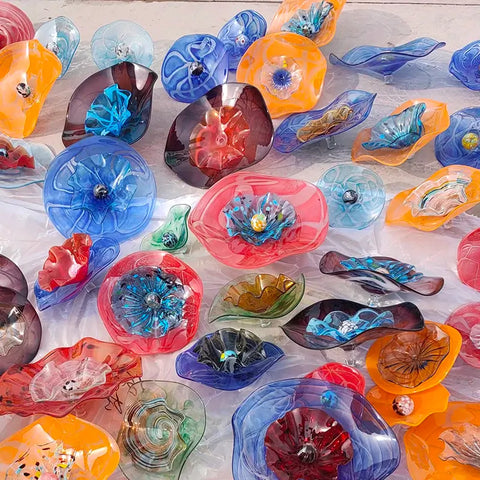
Ultimate Crystal Chandelier Buyer's Guide
Share
As an interior design enthusiast, few lighting fixtures captivate me as much as crystal chandeliers. These dazzling masterpieces possess an unparalleled ability to transform any space into a realm of radiant sophistication. In this guide, I'll unveil the secrets behind selecting the perfect crystal chandelier, ensuring your home shines with unmatched brilliance.
Introduction to Crystal Chandeliers
A crystal chandelier is a suspended lighting fixture adorned with multifaceted crystals that refract and reflect light, creating a mesmerizing display of luminous beauty. These chandeliers have graced the grandest ballrooms and opulent estates for centuries, but today, they're accessible to elevate any residential interior.
The enchanting history of crystal chandeliers can be traced back to the 15th century when highly skilled Venetian glassmakers pioneered techniques to craft intricate, sparkling light fixtures. As the demand for these luxurious pieces grew, so did the innovation in crystal manufacturing, leading to the birth of world-renowned brands like Swarovski.
Understanding the Quality of Chandelier Crystals
Before delving into the types of crystal chandeliers, it's crucial to comprehend the factors that determine crystal quality. The composition, manufacturing process, and cut significantly impact a chandelier's brilliance and durability.
What's Inside?
The primary component of chandelier crystals is lead oxide, also known as lead glass. This addition enhances the crystal's refractive index, allowing light to bend and disperse more effectively, resulting in a dazzling sparkle. However, some manufacturers have shifted towards lead-free alternatives like potassium or barium for environmental and safety reasons.
How They're Made Matters
The manufacturing process plays a pivotal role in determining a crystal's clarity and optical properties. Handcrafted crystals, though exquisite, may contain slight imperfections, while machine-cut crystals boast precise faceting and uniformity.
Handcrafted Crystals:
- Made by skilled artisans
- Unique, one-of-a-kind pieces
- May have slight imperfections
Machine-Cut Crystals:
- Automated precise cutting
- Consistent, uniform faceting
Cut to Perfection
Not all crystal cuts are created equal when it comes to light refraction and dazzle factor. Here are some stunners:
- Octagon Cut - Traditional 8-sided design for excellent light dispersion.
- Icicle Cut - Elongated, pointy crystals create a dramatic cascading effect.
- Rosette Cut - Inspired by roses, these floral-inspired cuts add a whimsical touch.
- Teardrop/Swedish Cut - Curved, rounded shape gives a softer sparkle.
- Baguette Cut - Sleek with flat and raised sides for a modern appeal.
So whether you want classic elegance or contemporary flair, the right crystal cut can give your chandelier show-stopping brilliance.
The Sparkling Varieties: Types of Crystal Chandeliers
Now that you understand the fundamentals of crystal quality, let's explore the most popular types of crystal chandeliers to help you find the perfect match for your space.
Swarovski(32% lead content): The Pinnacle of Sparkle
Swarovski crystals, crafted in the Austrian Alps, are renowned for their exceptional clarity and precision cutting. These lead-glass crystals undergo a proprietary coating process that enhances their durability and brilliance, making them a favorite among luxury chandelier designers. While Swarovski chandeliers come with a premium price tag, their unmatched sparkle and quality are well worth the investment for those seeking the ultimate in opulence.

Rock Crystal: Natural Crystal
For a truly unique and sustainable option, consider rock crystal chandeliers. These fixtures are adorned with naturally occurring quartz crystals, each possessing its own distinctive shape and inclusions. Rock crystal chandeliers offer an organic, one-of-a-kind beauty that reflects the wonders of nature, making them a stunning choice for eco-conscious homeowners.

Asfour Crystal(24% to 30% lead content): Egyptian Craftsmanship
Originating from the heart of Egypt, Asfour crystals are renowned for their exceptional clarity and brilliant refraction. These lead-glass crystals are meticulously handcrafted by skilled artisans, ensuring each piece is a work of art. While Asfour crystals are slightly more affordable than Swarovski, they still offer a luxurious touch with their high-quality craftsmanship.

K9 Crystal(9% to 12% leda content): Affordable Brilliance
If you're seeking a budget-friendly alternative without compromising on sparkle, K9 crystal chandeliers may be the perfect choice. K9, also known as optical crystal, is a lead-free glass composed of borosilicate and barium. Its high refractive index and exceptional clarity make it an excellent option for those seeking a dazzling chandelier without breaking the bank.

Murano Glass: Venetian Charm
Imbued with centuries of tradition, Murano glass chandeliers are a true embodiment of Italian artistry. These fixtures are crafted from glass sourced from the renowned Venetian island of Murano, where skilled glassmakers have perfected their craft for generations. Murano glass chandeliers offer a unique, organic beauty with their vibrant colors, intricate patterns, and stunning light refraction.

How to Choose the Right Crystal Chandelier for Your Home
With so many captivating options, selecting the perfect crystal chandelier for your space can be a daunting task. Here are some essential considerations to guide your decision:
Make Sure it's Real Crystal
When shopping for a crystal chandelier, don't get fooled by fake materials. Real crystal is way better than acrylic or regular glass. How can you tell? Look at the product details - it should clearly state that it's made of genuine crystal like Swarovski, rock crystal, Asfour, or K9 crystal glass. Acrylic may look clear but it lacks that brilliant, prismatic sparkle that real crystal has. And regular glass just doesn't have the same light refracting abilities as crystal.
Consider Light Refraction and Ambiance
The sparkle factor of your crystal chandelier depends on its light refraction abilities. High-quality, super clear crystals refract and bend light in a spectacular way to create brilliant, dramatic effects. If you want a real "wow" centerpiece, opt for maximum refraction.
But maybe you prefer a more subtle, soft glow? Then look for chandeliers with lower clarity crystals that still sparkle, just in a more subdued fashion.
Style It Your Way
Crystal chandeliers now come in all sorts of designs from classic to modern, simple to elaborate. So have some fun with it! If your home has a more traditional vibe, maybe an ornate, cascading crystal fixture fits best. But if your style is more minimalist and contemporary, a sleek, geometric design could be the perfect touch. Think about your overall decor aesthetic and find a chandelier that blends right in.
Brilliant Budgeting
Of course, you'll need to consider your budget too. Swarovski crystals are the cream of the crop quality-wise, but they come with a premium price tag. Rock crystal gives you stunning, one-of-a-kind organic beauty in a more sustainable way. Asfour crystal from Egypt offers that high-end vibe without quite the splurge. And K9 crystal is a brilliant choice if you want sparkling looks for less.
To keep it simple:
Price from highest to lowest: Swarovski > Rock Crystal > Asfour > K9 Crystal
Care and Maintenance
To ensure your crystal chandelier maintains its radiant beauty for years to come, proper care and maintenance are essential. Here are some tips to keep your chandelier sparkling:
Keeping it Sparkling Clean
Daily Dusting:
- Use a gentle lint-free cloth
- Lightly wipe down crystals and frame
- Prevents dust build-up
Deep Cleaning:
- Remove crystals carefully
- Use mild soap and warm water
- Avoid harsh scrubbing or cleaners
- Dry thoroughly before re-hanging
Regular Maintenance for Durability
Inspect your chandelier periodically for any loose crystals or hardware, and promptly address any issues to prevent further damage. It's also advisable to have your chandelier professionally cleaned and serviced every few years to ensure optimal performance and longevity.
Conclusion
Choosing the perfect crystal chandelier is an art form, one that harmoniously blends beauty, quality, and personal style. By understanding the nuances of crystal types, cuts, and manufacturing processes, you can confidently navigate the everchanging world of lighting design to find a fixture that truly illuminates your space with unparalleled elegance.
Whether you're captivated by the timeless allure of Swarovski, the sustainable charm of rock crystal, or the affordability of K9, there's a crystal chandelier waiting to elevate your interior and create a dazzling ambiance that will leave a lasting impression on all who enter.
Questions about Crystal Chandeliers?
What type of crystal is used in chandeliers?
The most common types of crystals used in chandeliers include Swarovski crystals, K9 optical crystals, Asfour crystals, and rock crystals (natural quartz). Each type offers unique qualities in terms of clarity, brilliance, and affordability.
How can you tell if a chandelier is real crystal?
Genuine crystal chandeliers will have a higher weight, increased brilliance and clarity when illuminated. Real crystal refracts light in a distinctive, sparkling way compared to glass or acrylic. Check the product details to confirm if it is advertised as being made from genuine crystal material like Swarovski, K9, Asfour or rock crystal.
What is the difference between crystal and glass?
The main difference is in composition - crystal contains lead oxide which increases its light refraction abilities. Glass is non-lead based and has a lower refractive index, so it doesn't quite achieve that brilliant, prismatic sparkle crystal is known for. Crystal is also generally more durable and scratch-resistant.
What is the difference between K5 and K9 crystals?
K5 and K9 refer to different formulations of optical glass used to make crystals. K9 has a higher refractive index than K5, meaning it refracts and disperses light better for enhanced brilliance and sparkle. K9 is considered superior quality for crystals and light fixtures.
